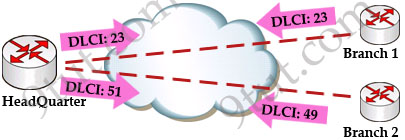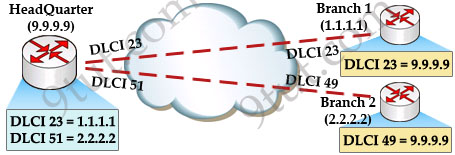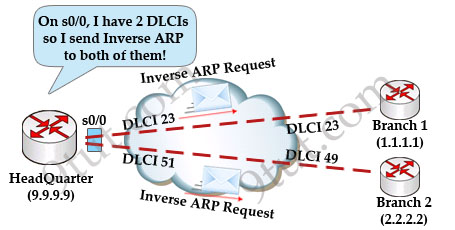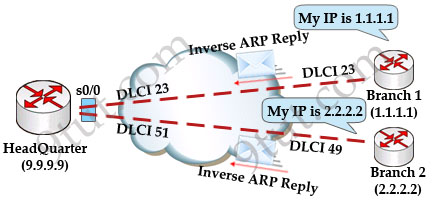Frame Relay Tutorial
In this part we will continue to discuss about other important Frame Relay parameters
DLCI
Although the above picture shows two VCs from the HeadQuarter but do you remember that the HeadQuarter only has only one serial interface? So how can it know which branch it should send the frame to?
Frame-relay uses data-link connection identifiers (DLCIs) to build up logical circuits. The identifiers have local meaning only, that means that their values are unique per router, but not necessarily in the other routers. For example, there is only one DLCI of 23 representing for the connection from HeadQuarter to Branch 1 and only one DLCI of 51 from HeadQuarter to Branch 2. Branch 1 can use the same DLCI of 23 to represent the connection from it to HeadQuarter. Of course it can use other DLCIs as well because DLCIs are just local significant.

By including a DLCI number in the Frame Relay header, HeadQuarter can communicate with both Branch 1 and Branch 2 over the same physical circuit.
DLCI values typically are assigned by the Frame Relay service provider (for example, the telephone company). In Frame Relay, DLCI is a 10-bit field.
Before DLCI can be used to route traffic, it must be associated with the IP address of its remote router. For example, suppose that:
+ HeadQuarter’s IP address is 9.9.9.9
+ Branch 1′s IP address is 1.1.1.1
+ Branch 2′s IP address is 2.2.2.2

Then the HeadQuarter will need to map Branch 1 IP address to DLCI 23 & map Branch 2 IP address to DLCI 51. After that it can encapsulate data inside a Frame Relay frame with an appropriate DLCI number and send to the destination. The mapping of DLCIs to Layer 3 addresses can be handled manually or dynamically.
* Manually (static): the administrators can statically assign a DLCI to the remote IP address by the following statement:
Router(config-if)#frame-relay map protocol dlci [broadcast]
For example HeadQuarter can assign DLCIs of 23 & 51 to Branch 1 & Branch 2 with these commands:
HeadQuarter(config-if)#frame-relay map ip 1.1.1.1 23 broadcast
HeadQuarter(config-if)#frame-relay map ip 2.2.2.2 51 broadcast
We should use the “broadcast” keyword here because by default split-horizon will prevent routing updates from being sent back on the same interface it received. For example, if Branch 1 sends an update to HeadQuarter then HeadQuarter can’t send that update to Branch 2 because they are received and sent on the same interface. By using the “broadcast” keyword, we are telling the HeadQuarter to send a copy of any broadcast or multicast packet received on that interface to the virtual circuit specified by the DLCI value in the “frame-relay map” statement. In fact the copied packet will be sent via unicast (not broadcast) so sometimes it is called “pseudo-broadcast”.
Note: “frame-relay interface-dlci” command can be used to statically assign (bind) a DLCI number to a physical interface.
Note: In fact, we need to run a routing protocol (like OSPF, EIGRP or RIP…) to make different networks see each other
* Dynamic: the router can send an Inverse ARP Request to the other end of the PVC for its Layer 3 address. In short, Inverse ARP will attempt to learn its neighboring devices IP addresses and automatically create a dynamic map table. By default, physical interfaces have Inverse ARP enabled.
We will take an example of how Inverse ARP works with the topology above. At the beginning, all routers are not configured with static mapping and HeadQuarter has not learned the IP addresses of Branch 1 & 2 yet. It only has 2 DLCI values on s0/0 interface (23 & 51). Now it needs to find out who are attached to these DLCIs so it sends an Inverse ARP Request on s0/0 interface. Notice that the router will send Inverse ARP Request out on every DLCI associated with the interface.

In the Inverse ARP Request, HeadQuarter also includes its IP 9.9.9.9. When Branch 1 & 2 receive this request, they send back an Inverse ARP Reply with their own IP addresses.

Now all the routers have a pair of DLCI & IP address of the router at the other end so data can be forwarded to the right destination.
In this example you can see that each router has a DLCI first (Layer 2) and it needs to find out the IP address (Layer 3). This process is opposite of the ARP process (ARP translates Layer 3 address to Layer 2 address) so it is called Inverse ARP.
After the Inverse ARP process completes, we can use the “show frame-relay map” to check. The word “dynamic” indicates the mapping was learned through Inverse ARP (the output below is not related to the above topology):
![]()
By default, routers send Inverse ARP messages on all active DLCIs every 60 seconds.
Another thing you should notice is when you supply a static map (via “frame-relay map” command), Inverse ARP is automatically disabled for the specified protocol on the specified DLCI.



It seems easy when you’re reading it, because the examples are simple.
When you are given network diagrams, sometimes the frame relay connection is portrayed as a solid line from router to router, implying a physical connection (as in the leased line example at the top) when this is not actually the case.
The first thing to do in these cases is work out where the frame relay cloud is situated, and (from the routing perspective), focus on the endpoints of each VC.
If you are dealing with a full mesh or ‘hub and spoke’ design, you can ignore the connections within the cloud itself. This is only important for a partial mesh where more than one router is taking on a distributive role.
When you are also required to perform configuration, it may help to use your note-taking materials in the exam to construct your own diagram. This way, you can keep the question on screen with your console, while having a diagram that you can edit if required.
Great work!
Thank you so much!
said Ed Perrott, there are actually numerous patchwork purses you can pick from. were piped over a distance of 16km to a tailing dam sited in Lohan Valley about 980m below the mine.?
i want to download this in pdf document how can i download it\.
thanks a lot for the tutorial, it clarified things…
so there is a frame-relay encapsulation type “cisco” and an LMI type “cisco” as well. 2 different things but the same name..
hi there,
I have appreciate your explanation and the tutorial was simple and nice to understanding .
thanks
madja
Thank you for a well explained and presented article
very easy for study
This is very easy to understand and usefully for a newbie like me. THANK YOU!
arrr
Hi,
Very nice explanation.Really helful.
I think there is a small mistake in diagram labeling. For branch-2 DLCI 51, but in diagram it shows DLCI -49..
Nasir uddin Pavel
Linux pathshala
Hi,
Very nice explanation.Really helful.
I think there is a small mistake in diagram labeling. For branch-2 DLCI 51, but in diagram it shows DLCI -49..
Nasir uddin Pavel
Linux pathshala
@Linux Pathshala: It is not a mistake. The DLCI 49 is used on Branch 2 for traffic to the HeadQuarter.
plsssssssssssss help for dis exami need dumps oooo
what is the difference b/w RARP and InARP…?
@ Adex
if u need CCNA 200-120 dumps i will provide of other then sorry…
HI
Very nice explaniation
But I have a question
For branch-2 DLCI 51, but in diagram it shows DLCI -49..
It is not a mistake. The DLCI 49 is used on Branch 2 for traffic to the HeadQuarter.
why HQ & branch-1 DLCI is 23 both sides, and HQ DLCI 51,For branch-2 DLCI is 49.
what about it if I had more than 2 branches
are those standards
Thank you
@jefdezp: It is not a mistake. We implied DLCI is a random number used by both devices so they can be the same (DLCI 23 between HQ & Branch1) or different (DLCI 51 & 49 between HQ & Branch2). If more branches are added they just use other DLCIs, provided they are different at the local routers.
In Frame Relay InARP is the extension for ARP whereas RARP is the Reverse Address Resolution Protocol.
nice
very easy explanation.. thanks
HI
very nice tutorial
Frame-relay is not a problem to me, is easy to work with it dose not require that much typing commands. good luck guys.
Excellent tutorial
Great article. A little confusion here—why do we need DLCI when we already have PVC Number?
superb tutorial
hi guys ! who are asking dumps over and over.
let me tell you
check everything on this site! Enough to pass!
You guys are awesome. God bless you dear.@9tut
nice explanation
Very nice explanations with simple understanding examples ..i love it
VCE PLAYER 1.1.7 crack is needed for my exams , can any one help ?
or is there other application which can open VCE files ?
thx in advance to send info on tn.touareg@live.fr
Did anyone do Boson simulations? I mean there are ICND1 ,ICND2 and CCNP for old syllabus. Is CCNP frame relay of Boson applicable to new CCNA(200-120) ?
Great work. thanks alot
the exam has changed. the dumps is now uselesss
what is the types that frame relay network transfer data?
Great piece of work! Full of information.
how bout CSU/DSU. how does it work?
got the frame relay concept..
This is the simplest way for explaining things in detail.
Hi, I think there is a mistake in the Quiz 11 question 43 about frame-relay mapping.
You have this situation.
R1 DLCI 100——————————————————–R2 DLCI 200
IP: 172.16.100.2/16 172.16.100.1
The configuration on R1 was : #frame-relay map ip 172.16.100.1 100 broadcast
Which in my concept is good!!
But in the quiz answers when you choose : “incorrect map statement ” then you have it right. But actually the configuration was good!!
Great tutorial!
VCE player higher version 1.1.7 or above , needed for my exam prctice. please help me >>>
my email : sarohan.sanjaya@gmail.com
I passed my icnd 1 last year August. this site played a huge part to that. Now im ont Icnd 2 in the nearest future. Thumbs up to the admin of this site
if you are only concerned with this MATERIAL because you want to pass the test…you have NO BUSINESS administering a live production site.
GET understanding first…and the exam will just be another boring example to you and you’ll be able to concentrate on TROUBLESHOOTING TECHNIQUES and how to GET to the answers effectively and quickly.
-M
wonderfull work thanks many
syed, to download to pdf, simply select entire text and right click (if you are using chrome) and choose print; one of your printers needs to be set up as a pdf output; it will save to that file then print
helpful thaxs
helpful thaxs
Simple and clear
nyce